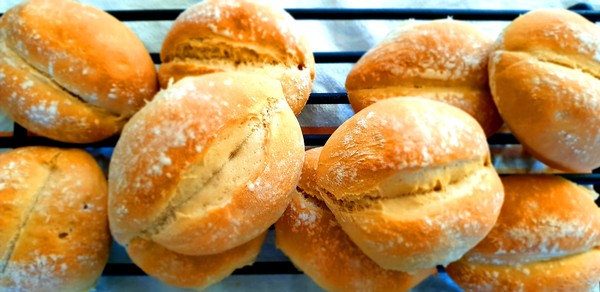Papo Secos (Portuguese Rolls)

These papo secos are light and fluffy Portuguese rolls that are the perfect vehicle for the classic prego sandwich.
Marthinus StrydomThe Story
The Papo Seco which literally means “dry throat” is the most popular bread eaten all over the country both in homes and a staple at every restaurant. Often people will say I have a “Papo Seco” to signify they need something to drink. The roll is crusty on the outside and light and airy in the center which make it perfect for sandwiches and for absorbing sauces.

Subscripe to my Facebook page.
Subscripe to my Youtube channel.
© All recipes are copyright protected by TheCultureCook.com unless the recipe was adapated from another source. All recipes are uniquely crafted and adapted by TheCultureCook.com. Copyright of some or all of the text reside with the original author.
Ingredients
Method
- In the bowl of a stand mixer mix the water, yeast, and sugar on low speed until combined. Let sit for 10 minutes until foamy.
- Add the flour, butter and stir on low until the ingredients are combined, 3 minutes. Cover with plastic and let sit for 30 minutes. Sprinkle the salt over the top of the dough and mix on low to medium for 10 minutes.
- Remove the bowl from the mixer, cover it with plastic wrap, and place in a warm (20°C to 22°C), draft-free spot. Let the dough double in size, about 1 hour.
- Reach down 1 side of the bowl and gently but firmly pull the dough up and fold it over itself. Don’t punch it down. Rotate the bowl a quarter turn and repeat. Continue turning and folding 2 more times. Cover and let rest until doubled in size, about 30 minutes.
- Repeat the turning and folding process, cover with plastic, and let the dough rest until doubled in size, about 30 minutes more.
- Divide the dough into ten equal pieces, about 120 grams each. Lightly flour your hands. Cup one hand over a chunk of dough and roll it on your work surface in a circle to tighten the ball. Place the balls on a baking sheet lined with a floured kitchen towel or a baker’s couche. Cover them with a kitchen towel. Let rest for 20 minutes.
- Transfer the balls to your work surface. Heavily dust the towel again. Roll the edges to create pointy ends. Use the back of a knife to create a deep crease across the ball.
- Gently transfer the papo seco to the towel, seam-side down. Pull the towel up between each row to create a ridge that will hold the shape of the rolls during proofing. Repeat the shaping and lining up the papo-secos, folding up the towel between rows.
- Cover the rolls with a towel and let rise in a warm place until almost doubled in size, about 30 minutes.
- Meanwhile, position a rack in the middle of the oven and slip in a baking stone. Place an empty metal tray on any rack that won’t interfere with the rising papo secos. Crank the heat to 260°C (500°F). The oven and stone will need time to properly heat.
- Coat a baking peel or rimless baking sheet with cornmeal. Carefully turn a few of the papo secos seam-side up and arrange them on the peel. Place the front edge of the peel at the back of the baking stone and quickly yank it toward you to shift the dough onto the baking stone. Repeat with the remaining papo secos. Quickly but carefully pour the hot water into the metal tray and immediately shut the oven door to trap the steam. Immediately reduce the heat to 218°C (425°F).
- Bake the papo secos until they’re puffed and golden brown, 15 to 20 minutes. Remove them from the oven and let them cool on a rack. To get that characteristic crusty outside, let the roll sit out several more hours prior to eating.
